Luminosity (bolometric) 0.22 L☉ Rotation 23 days Apparent magnitude (V) 4.69 | Magnitude 4.69 Constellation Indus | |
 | ||
Similar Epsilon Eridani, EZ Aquarii, Groombridge 34, Lacaille 9352, Luyten's Star | ||
Epsilon indi starbound original soundtrack
Epsilon Indi (ε Indi, ε Ind) is a star system approximately 12 light-years from Earth in the constellation of Indus consisting of a K-type main-sequence star, ε Indi A, and two brown dwarfs, ε Indi Ba and ε Indi Bb, in a wide orbit around it. The brown dwarfs were discovered in 2003. ε Indi Ba is an early T dwarf (T1) and ε Indi Bb a late T dwarf (T6) separated by 0.6 arcseconds, with a projected distance of 1460 AU from their primary star.
Contents

Observation

The constellation Indus (the Indian) first appeared in Johann Bayer's celestial atlas Uranometria in 1603. The 1801 star atlas Uranographia, by German astronomer Johann Elert Bode, places Epsilon Indi as one of the arrows being held in the left hand of the Indian.

In 1847, Heinrich Louis d'Arrest compared the position of this star in several catalogues dating back to 1750, and discovered that it possessed a measureable proper motion. That is, he found that the star had changed position across the celestial sphere over time. In 1882–3, the parallax of Epsilon Indi was measured by astronomers David Gill and William L. Elkin at the Cape of Good Hope. They derived a parallax estimate of 0.22 ± 0.03 arcseconds. In 1923, Harlow Shapley of the Harvard Observatory derived a parallax of 0.45 arcseconds.

During Project Ozma in 1960, this star was examined for artificial radio signals, but none were found. In 1972, the Copernicus satellite was used to examine this star for the emission of ultraviolet laser signals. Again, the result was negative. Epsilon Indi leads a list, compiled by Margaret Turnbull and Jill Tarter of the Carnegie Institution in Washington, of 17,129 nearby stars most likely to have planets that could support complex life.
Characteristics

Epsilon Indi A is a main-sequence star of spectral type K4.5V. The star has only about three-fourths the mass of the Sun. Its surface gravity is slightly higher than the Sun's. The metallicity of a star is the proportion of elements with higher atomic numbers than helium, being typically represented by the ratio of iron to hydrogen compared to the same ratio for the Sun; Epsilon Indi A is found to have about 87% of the Sun's proportion of iron in its photosphere.
The corona of Epsilon Indi A is similar to the Sun, with an X-ray luminosity of 2×1027 ergs s−1 and an estimated coronal temperature of 2×106 K. The stellar wind of this star expands outward, producing a bow shock at a distance of 63 AU. Downstream of the bow, the termination shock reaches as far as 140 AU from the star.
This star has the third highest proper motion of any star visible to the unaided eye, after Groombridge 1830 and 61 Cygni, and the ninth highest overall. This motion will move the star into the constellation Tucana around 2640 AD. Epsilon Indi A has a space velocity relative to the Sun of 86 km/s, which is unusually high for what is considered a young star. It is thought to be a member of the ε Indi moving group of at least sixteen population I stars. This is an association of stars that have similar space velocity vectors, and therefore most likely formed at the same time and location.
As seen from Epsilon Indi, the Sun is a 2.6-magnitude star in Ursa Major, near the bowl of the Big Dipper.
Companions
In January 2003, astronomers announced the discovery of a brown dwarf with a mass of 40 to 60 Jupiter masses in orbit around Epsilon Indi A at a distance of at least 1,500 AU. In August 2003, astronomers discovered that this brown dwarf was actually a binary brown dwarf, with an apparent separation of 2.1 AU and an orbital period of about 15 years. Both brown dwarfs are of spectral class T; the more massive component, Epsilon Indi Ba, is of spectral type T1–T1.5 and the less massive component, Epsilon Indi Bb, of spectral type T6.
Evolutionary models have been used to estimate the physical properties of these brown dwarfs from spectroscopic and photometric measurements. These yield masses of 47 ± 10 and 28 ± 7 times the mass of Jupiter, and radii of 0.091 ± 0.005 and 0.096 ± 0.005 solar radii, for Epsilon Indi Ba and Epsilon Indi Bb, respectively. The effective temperatures are 1300–1340 K and 880–940 K, while the log g (cm s−1) surface gravities are 5.50 and 5.25, and their luminosities are 1.9 × 10−5 and 4.5 × 10−6 the luminosity of the Sun. They have an estimated metallicity of [M/H] = –0.2.
Measurements of the radial velocity of Epsilon Indi by Endl et al. (2002) appear to show a trend that indicated the presence of a planetary companion with an orbital period of more than 20 years. A substellar object with minimum mass of 1.6 Jupiter masses and orbital separation of roughly 6.5 AU could explain the observed trend. If confirmed, it would be a true Jupiter-analogue.
A visual search using the ESO's Very Large Telescope found one potential candidate. However, a subsequent examination by the Hubble Space Telescope NICMOS showed that this was a background object. As of 2009, a search for an unseen companion at 4 μm failed to detect an orbiting object. These observations further constrained the hypothetical object to be 5–20 times the mass of Jupiter, orbiting between 10–20 AU and have an inclination of more than 20°. Alternatively, it may be an exotic stellar remnant.
New radial-velocity measurements on Epsilon Indi, using the Echelle spectrometer on the HARPS telescope, following up on Endl et al. (2002) research findings, were published in a paper recently by M. Zechmeister et al. in 2013. The new findings confirm that, quoting the paper, "Epsilon Ind A has a steady long-term trend still explained by a planetary companion". This updated research refines the radial-velocity trend previously observed and now indicate the presence of a planetary companion with an orbital period of greater than 30 years. A gas giant with a minimum mass of 0.97 Jupiter masses and a minimal orbital separation of roughly 9.0 AU could explain the observed trend. 9.0 AU is about the same distance out as Saturn. If confirmed, this would not quite qualify the planet as a true Jupiter analogue because it orbits considerably further out than 5.0 AU. Not only does it orbit further out than Jupiter, but Epsilon Indi A is also dimmer than the Sun, so it would only receive about the same amount of energy per square meter from Epsilon Indi A as Uranus does from the Sun. The radial-velocity trend was observed through all the observations so far taken using the HARPS telescope but due to the long time period predicted for just one orbit of the object around Epsilon Indi A, more than 30 years, the astrometric phase coverage is not yet complete.
No excess infrared radiation that would indicate a debris disk has been detected around Epsilon Indi. Such a debris disk could be formed from the collisions of planetesimals that survive from the early period of the star's protoplanetary disk.
